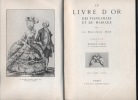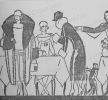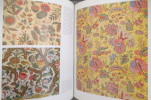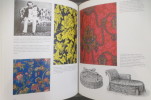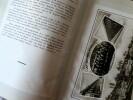-
Type
Book (799)
Drawings (13)
Magazine (8)
Object book (1)
-
Language
English (3)
French (818)
-
Century
17th (2)
18th (7)
19th (55)
20th (378)
21st (65)
-
Countries
Belgium (84)
Canada (1)
China (2)
Côte d'Ivoire (1)
Denmark (2)
France (705)
Greece (1)
Switzerland (25)
-
Syndicate
ALAC (1)
ILAB (280)
NVVA (3)
SLACES (3)
SLAM (273)
SNCAO (1)
Hoards from the European Bronze and Iron Ages. Current Research and New Perspectives
, Brepols, 2025 Paperback, 175 pages, Size:216 x 280 mm, Illustrations:42 b/w, 72 col., 6 tables b/w., 17 maps b/w, 3 maps color, Language: English. *new ISBN 9782503607511.
Summary Hoards are among the most enigmatic of archaeological finds. The term 'hoard' itself has been applied to different assemblages across space and time, from the Stone Age into the modern era, with an inventory that typically includes artefacts made of valuable raw materials, to which significant symbolic meanings can also be assigned. Archaeologists have been trying to understand this phenomenon for much of the last century, sometimes emphasizing the universal nature of hoards, but more typically focusing on specific regions, chronologies, and finds. They have, for the most part, used results derived from typolo-chronological methods. Contemporary archaeology has, however, developed a broad spectrum of paradigms and methods, and hoardresearch in the twenty-first century draws on an increasingly wide range of approaches. This volume presents examples of research that make use of these multi-faceted approaches through a focus on European hoards of metal objects dating to the Bronze and Iron Ages. The contributors to this volume make use of diverse methods, among them archaeometallurgical analyses, studies of use- and production-wear, destruction patterns, and landscape archaeology, but together, their common denominator is the search for a methodological toolkit that will allow researchers to better understand the phenomenon of hoard-deposition more broadly. TABLE OF CONTENTS List of Illustrations 1. Hoards Research - Past, Present, Future. A Few Words of Introduction Marcin Maciejewski, J nos G bor Tarbay, and Kamil Nowak 2. In an Interpretive Triangle. Main Trends in Research on Hoards in the Nineteenth and Twentieth Centuries: A Central European Perspective Wojciech Blajer 3. The Cognitive Development of Prehistoric Wetland Deposition Tradition Through Mnemonics. Case Studies of Iron Age Wales and Scotland Tiffany Treadway 4. There is a Light that Never Goes Out! New and Old Hoards from the Northern Adriatic Martina Ble?i? Kavur 5. The Urnfield Period Metal Hoards in South Bohemia. Find Circumstances, Topography, and Analyses Ond?ej Chvojka, Jan John, Ji? Kmo?ek, and Tereza ? lkov 6. An Active Search for Hoards? Contributions of a Systematic Field Survey to the Knowledge of Bronze Age Metal Hoarding. The Case Study of Salins-les-Bains, Jura, France Estelle Gauthier and Jean-Fran ois Piningre 7. Ice-marginal Valleys and Hoards. Natural Landscapes, Cultural Practices and their Amazing Convergence in Different Regions of Central Europe (Poland) Marcin Maciejewski 8. Twin Hoards and Hoard Selections from the Late Bronze Age Transdanubia J nos G bor Tarbay 9. Late Bronze Age Hoard from Nowe Kramsko. Is there a Method in Fragments? Kamil Nowak and Nicola Ialongo 10. Comparative Technological Analysis of Middle Bronze Age Bronze Objects from Hoards and Burials Szilvia Gy ngy si, P ter Bark czy, Julianna Cseh, Laura Juh sz, and G za Szab 11. Re-theorizing Deposition in Bronze Age Europe Kristian Kristiansen
Hoards from the European Bronze and Iron Ages Current Research and New Perspectives
, Brepols - Harvey Miller, 2025 paperback, Pages: 175 pages, Size:216 x 280 mm,Illustrations:42 b/w, 72 col., 6 tables b/w., 17 maps b/w, 3 maps color. Language(s):English. *new. ISBN 9782503607528.
Hoards are among the most enigmatic of archaeological finds. The term ?hoard? itself has been applied to different assemblages across space and time, from the Stone Age into the modern era, with an inventory that typically includes artefacts made of valuable raw materials, to which significant symbolic meanings can also be assigned. Archaeologists have been trying to understand this phenomenon for much of the last century, sometimes emphasizing the universal nature of hoards, but more typically focusing on specific regions, chronologies, and finds. They have, for the most part, used results derived from typolo-chronological methods. Contemporary archaeology has, however, developed a broad spectrum of paradigms and methods, and hoardresearch in the twenty-first century draws on an increasingly wide range of approaches. This volume presents examples of research that make use of these multi-faceted approaches through a focus on European hoards of metal objects dating to the Bronze and Iron Ages. The contributors to this volume make use of diverse methods, among them archaeometallurgical analyses, studies of use- and production-wear, destruction patterns, and landscape archaeology, but together, their common denominator is the search for a methodological toolkit that will allow researchers to better understand the phenomenon of hoard-deposition more broadly.
Le Livre d'or des fiançailles et du mariage par le bibliophile Jean.
Paris 1 Préface de Maurice Vitrac. Paris, sans date, in-8, percaline bordeaux, 260 pp.
Intéressant livre illustré de nombreuses reproductions sur l'histoire des fiançailles, du mariage, de leurs costumes et accessoires. Petites usures à la couverture.
Les COUSSINS
Un guide de 63 pages, format 180 x 120 mm, broché, illustré, publié en 1978, Editions Solarama
Guide pratique pour la confection des coussins
Phone number : 04 74 33 45 19
Conceptualizing Bronze Age Seascapes. Concepts of the Sea and Marine Fauna in the Eastern Mediterranean in the Second Millennium BCE
, Brepols - 2023, 2023 Paperback, x + 218 pages, Size:216 x 280 mm, Illustrations:20 b/w, 7 col., 13 tables b/w., 3 maps b/w, Language: English. ISBN 9782503606477.
Summary The Mediterranean has, for millennia, formed the heart of an intensive trading network of ideas, goods, and people. For the ancient populations of the Levant, Cyprus, and Southern Anatolia, interactions with the sea ? from fishing to seafaring, and from trade to dye production ? were a constant presence in their life. But how did the coastal peoples of the Bronze Age understand the sea? How did living on the shore influence their lives, from daily practices to mythological beliefs? And what was the impact on their conceptual world? This volume seeks to engage with these questions by addressing the relationship between environment, diet, material production, perception, and thought formation through a combination of archaeological analysis and engagement with primary sources, and in doing so, it offers unique insights into the conceptual world of the ancient Mediterranean maritime cultures of the 2nd millennium BCE. TABLE OF CONTENTS Acknowledgements List of Abbreviations List of Common and Scientific Names of Fish and Molluscs Mentioned in the Text Part I: Framework Chapter 1. Introduction Objectives Organization of the Book Chapter 2. History, Theory, and Methods State of the Art Theoretical Framework Chronological Framework The Evidence Part II: Regional Chapters Chapter 3. Levant Faunal and Material Cultural Evidence Textual Evidence Discussion Chapter 4. Cyprus Faunal and Material Cultural Evidence Textual Evidence Discussion Chapter 5. Southern Anatolian Coast Faunal and Material Cultural Evidence Textual Evidence Discussion Part III: Overarching Analysis Chapter 6. Concepts of Marine Fauna Marine Fauna as Food Fish and Molluscs: Offerings and Purity Marine Fauna as Status or Commodity Visual Concepts of Marine Fauna Chapter 7. Concepts of the Sea The Sea as a Place The Sea as a Supernatural Force The Sea as a Divine Entity Chapter 8. Conclusions: Concepts of Seascapes Works Cited Index
Le Bas à travers les âges suivi de : Ce qu'il est de bon ton d'acheter.
Paris Marny 1925 1 in-16 Paris, Marny, premier bonnetier de Paris, Imprimerie Française de l'Edition,1925, in-16, broché, couverture, titre imprimé en rouge, 128 pp.
Ouvrage indispensable pour tout savoir sur les bas et les chaussettes illustré en noir, écrit et édité par MARNY, premier bonnetier de Paris installé rue Tronchet... Taches et manques à la couverture.
Notre costume.
A LA LAMPE D'ALADDIN 1926 1 Liège, A la Lampe d'Aladdin, 1926, in-12, br., 122 pp.
Réflexion sur l'abandon du Smoking et de l'Habit, sur la chaussure et le chapeau, sur le choix de la cravate et la manière de la nouer, sur la chemise, les cannes et les gants. Ouvrage numéroté sur papier vergé baroque thé. Lég. corné.
Les Cannes de M. Paul Bourget et Le Bon Choix de Philinte. Petit Manuel de l'Homme Elégant.
Paris LE DIVAN 1923 1 in-8 Illustrations d'Henri FARGE. Paris, Le Divan, 1923, in-8, demi veau corail, tête dorée, 288 pp.
"L'homme est le seul animal qui s'habille...le seul être qui ait une idée claire de la beauté". Cet ouvrage n'est que propos encourageant cette quête de l'élégance. Eugène MARSAN y portraitise "quelques artistes littéraires" touchés de dandysme ( BARBEY d'AUREVILLY, BAUDELAIRE, BALZAC,...). Eaux-fortes en couleur et bois racés de Henri FARGE. Un des 240 ex. numéroté sur papier de Monval. Trés légères piqures et taches.
Théorie pratique ou l'art du tailleur.
MARSAUD 1 Paris, Marsaud, (1860), in-4, reliure percaline vert sapin remontée sur reliure cartonnée et toilée, titre doré gravé en reliure sur le plat, 32 planches lithographiés en noir, 62 pages.
Troisième édition d'un manuel de tailleur de costumes pour hommes complété de nombreuses figures et explications sur les mesures, les coupes et les techniques nécessaires à l'exécution des modèles. Reliure postérieure.
Le batik premières notions
Dessain et Tolra 1982 In-8 broché 21 cm sur 18,3. 61 pages. Tranche supérieure touchée par l’humidité, intérieur frais bon état d’occasion.
Traduit de l’anglais par Caroline Cour et Marianick Bourdais Bon état d’occasion
MARTINIANI-REBER, Marielle - Direction des musées de France/Inventaire des collections publiques françaises
Reference : 102462
(1986)
Lyon, Musée historique des tissus. Soieries sassanides, coptes et byzantines Ve-XIe siècles
1986 Editions de la Réunion des musées nationaux, Paris - 1986 - Ministère de la Culture et de la Communication - In-8, broché, couverture illustrée - Illustrations en noir et blanc in et hors-texte dans l'ouvrage.
Bon état
Jan van Eyck?s Crucifixion and Last Judgment: Solving a Conundrum
, , Hardcover Pages: 195 pages, Size:225 x 300 mm Illustrations:170 col. Language(s):English. ISBN 9782503596907.
R p tons-le: Maryan W. Ainsworth propose un ouvrage la pointe de l? rudition et du savoir; f licitons-la aussi pour l?iconographie tr s riche, n?obligeant pas le lecteur rechercher les figures travers le livre. Regrettons cependant l?absence d?index, des personnes, des lieux et des ?uvres. (Jacques Paviot, dans Francia-Recensio, 4, 2023) BIO Maryan Ainsworth is Curator Emerita in the Department of European Paintings, The Metropolitan Museum of Art, New York Sophie Scully is Assistant Conservator in the Department of Paintings Conservation, The Metropolitan Museum of Art, New York Silvia Centeno is Research Scientist in the Department of Scientific Research, The Metropolitan Museum of Art, New York Marc Smith is Professor of Paleography at the cole des Chartes in Paris, France Christina Meckelnborg is Professor Emerita of Classical and Medieval Studies at the University of Osnabr ck, Germany SUMMARY Among the most intriguing and confounding works of Jan van Eyck?s oeuvre are the Crucifixion and Last Judgment in New York?s Metropolitan Museum of Art. Although acquired in 1933 as a diptych, questions have remained about their initial configuration, and how these paintings functioned. The recent technical investigations of the paintings and their original frames added further complexities to these inquiries when a fragmentary text in Middle Dutch was discovered through X-radiography on the frames surrounding the two paintings. The many facets of the ensuing investigation necessitated an interdisciplinary collaboration of researchers involving an art historian, paintings conservator, and museum scientist ? namely, Maryan Ainsworth, Sophie Scully, and Silvia Centeno. Moreover, the new discovery of the formerly hidden text called for the enrichment of the interdisciplinary team by a paleographer and a classical philologist, Marc Smith and Christina Meckelnborg. This book relates the unfolding story of the investigations from in-depth technical research, facilitating the conservation treatment of the frames, to the art historical study that connected these findings to the religious, political, and social contexts of the times. Through considerable interdisciplinary detective work, it was possible to reach a new understanding about the original form and function of the Crucifixion and Last Judgment and their pivotal role concerning devotions to a cherished relic, the Miraculous Bleeding Host, housed in the then collegiate church of Saint Michael and Saint Gudula in Brussels. The implications of these discoveries also shed new light on the relationship between The Met Crucifixion and Van Eyck?s metalpoint drawing of the same theme in the Museum Boijmans Van Beuningen, Rotterdam. Finally, the study of the Crucifixion and the Last Judgment draws attention to commissions Van Eyck received that are somewhat outside of the canon of works usually associated with this esteemed artist. TABLE OF CONTENTS Introduction Maryan W. Ainsworth The Technical Examination and Restoration of the Frames Sophie Scully and Silvia A. Centeno In Search of the Original Form and Function of the Crucifixion and Last Judgment Maryan W. Ainsworth Investigating Van Eyck?s Working Technique Sophie Scully and Silvia A. Centeno Attribution and Dating Questions in Historical Context Maryan W. Ainsworth Reconsidering the Relationship Between The Met Painting and the Rotterdam Crucifixion Drawing Maryan W. Ainsworth Appendix A. Deciphering the Middle Dutch Text on the Crucifixion and Last Judgment Frames Marc Smith ? Appendix B. Transcriptions of the Texts within the Crucifixion and Last Judgment Christina Meckelnborg Bibliography
Patchwork japonais
Soline 1999 In-4 reliure éd. sous jaquette 28,5 cm sur 22,5. 127 pages. Jaquette en assez bon état. Bon état d’occasion.
Bon état d’occasion
TISSUS FRANCAIS D'AMEUBLEMENT. De 1760 à nos jours.
1991 / 223 pages. Relié avec jaquette. Editions Flammarion.
Très bon état.
Tableau de la mode. Tableaux Contemporains n°6.
Paris N.R.F. 1926 1 Illustrations de VERTES. Paris, Editions de la Nouvelle Revue Française, 1926, in-8, broché, couverture imprimée rempliée, 190 pp.
La mode est élevée ici au rang de Religion, avec moultes descriptions et anecdotes sur ses officiants, des manequins aux grands couturiers, avec un chapitre consacré aux parfums et en conclusion le lexique d'une planète "up to date". 21 gravures à l'eau-forte et 11 lithographies enlevées et hautes en couleurs de Marcel VERTES, chantre de la mode et des femmes. Un des 300 exemplaires numérotés sur Vélin pur Fil Lafuma-Navarre. Infimes taches.
"MATERIALS FOR ORNAMENTATION, BRIDGES AND ROADS - SPECIMENS - ÉCHANTILLONS.
Reference : 58546
(1867)
Caption titles: Programme ou résumé des Lecons d'un cours de Constructions (Matériaux de construction). Atlas Livraison 1 et 2).
Paris, Dunod, 1867. Folio-oblong. (38,5 x 56 cm.). Contemp. hcalf. Titlelabel with gilt lettering on upper board. Spine rubbed. Original printed wrappers. Containing 6 engraved or lithographed plates. No 1 shows a large collection of mining-tools for stone carving and polishing. No 2 shows different pits, quarries from where the stones are extracted. No 3 depits 12 specimens, handcoloured or in chromolithography, of different kinds of stones (Pierres dures), granites, porphyrs etc. No 4. 12 specimens, handcoloured or in chromolithography, of different kinds of marble (Marbres simples). No 5. 12 specimens, handcoloured or in chromolithography of marble with intrusions (Marbres brèches et brocatelles). No 6. 12 specimens, handcoloured or in chromolithography of composed marble (Mabres composés et lumachelles).
This volume is the first two parts (Livraison 1 et 2) of Sganzin - Reibel's ""Programme ou Résumé des Lecons d'un Cours de Construction, avec des Applications tirées spécialement de l'Art de l'Ingenieur des Ponts et Chaussées. Cinquieme Édition, entirement refondue par Leon Lalanne."" The fifth edition seems to be the first containing these plates with materials added by Léon Lalanne.
MATHON & DUBRULLE Filatures, tissages, teintures, apprêts Tourcoing France sd (1929)
in4 reliure cartonné à motif or et noir contrecollé, photos nb en héliogravures - texte en français et anglais
couverture légèrement frottée aux arêtes sinon bel état - TOURCOING - NORD - TEXTILE - PUBLICITE - FILATURE - TISSUS
Individualizing the Dead. Attributes in Palmyrene Funerary Sculpture
, Brepols, 2021 Paperback, xvi + 140 pages, Size:216 x 280 mm, Illustrations:107 b/w, Language: English. ISBN 9782503591261.
Summary During the Roman era, when the ancient city of Palmyra was at the height of its powers, several thousand funerary portraits were sculpted, each carefully crafted to represent the men, women, and children who had once lived there as members of the Palmyrene elite. In their commemorative monuments, these individuals were given specific attributes to express their social status, wealth, identity, and skills. This volume provides an in-depth exploration of different aspects of these funerary portraits, and illuminates in particular the addition of attributes and how and why they were used by both artists and their patrons. The eight contributions gathered here examine the range of choices available to commissioners of art works in Palmyra, the prevalence or rarity of specific attributes, and the ways in which the variation and selection of attributes could be used in funerary, religious, or public contexts to express social cohesion and group identity, as well as to demonstrate individuality. Crucially, while these funerary monuments may be closely associated with Palmyra, they in fact provide clear evidence of the city's relationships across the wider region: examination of the different attributes suggests that the Palmyrenes were aware of how these were used, perceived, and adapted by neighbouring people as a way of transmitting various social meanings and expressing their own values. TABLE OF CONTENTS Table of Contents List of Illustrations Attributes in Palmyrene Funerary Sculpture: Functions and Meanings - MAURA HEYN AND RUBINA RAJA The 'Fringed' Mantle and its Relation to Gender in Palmyrene Funerary Sculpture - FRED ALBERTSON Plants in Palmyrene Funerary Iconography of Adults - OLYMPIA BOBOU Unlocking a Mystery? The Keys in Palmyrene Funerary Portraiture - RIKKE RANDERIS THOMSEN Significance of the Drinking Attributes in Palmyrene Banquet Scenes - MAURA HEYN Adornment and Jewellery as a Status Symbol in Priestly Representations in Roman Palmyra: The Palmyrene Priests and their Brooches - RUBINA RAJA A Symbol of a City. The Iconography of the Palmyrene Coinage - NATHALIA B. KRISTENSEN Why No Attributes? Expressions of Status and Social Realities in the Epigraphy of Palmyra - JEAN-BAPTISTE YON Index
Reines de saba : itinéraires textiles au yemen
Edisud 2010 In-4 broché 29,4 cm sur 20,8. Très bon état d’occasion.
Très bon état d’occasion
Modes Anciennes.
1908 Sans lieu, ni éditeur, (1908), in-12, cartonnage bleu-orné de motifs floraux d'or-pastichant une reliure.
Catalogue illustré des gravures d'autrefois présentant des fourrures portées par les élégantes du XIIe au XVIIe siècle où se suivent Agnès Sorel, Marie d'Anjou, Madame de Maintenon... Infimes usures et piqures.
Modes Anciennes.
1908 Paris, Draeger, (1908), in-12, cartonnage bleu-orné de motifs floraux d'or-pastichant une reliure, 8 planches lithographiées en couleur.
Catalogue illustré des gravures d'autrefois présentant des fourrures portées par les élégantes du XIIe au XVIIe siècle où se suivent Agnès Sorel, Marie d'Anjou, Madame de Maintenon... Petites usures et infimes taches.
Modes Anciennes.
1908 Paris, Draeger, (1908), in-12, cartonnage bleu-orné de motifs floraux d'or-pastichant une reliure, 8 planches lithographiées en couleur.
Catalogue illustré des gravures d'autrefois présentant des fourrures portées par les élégantes du XIIe au XVIIe siècle où se suivent Agnès Sorel, Marie d'Anjou, Madame de Maintenon... Infimes usures, borchage fragile. Collection Draeger - ex-libris.
MAX-LEROY & SCHMID. DRIAN (Etienne), BARBIER (George), MARTIN (Charles), VINCENT (René).
Reference : 11270
(1912)
Fourrures-portraits-miniatures.
Draeger 1912 1 Montrouge, Draeger, (1912), in-4, cartonné, couverture imprimée avec une vignette contrecollée, façon miniature, [24 pp.]
Précieux catalogue, illustraté de 4 planches en couleurs, par Charles MARTIN, DRIAN, George BARBIER et René VINCENT, présentant leur nouvelle collection et montrant la fourrure portée au XVIIIème siècle. Nombreuses photos de FELIX et BRISSY. Débrochage, usures à la couverture et légères déchirures.
La production et le commerce du chanvre en Italie. Thèse.
Codogno, 1936, 240x170mm, 93pages, broché. Bel exemplaire.
Pour un paiement via PayPal, veuillez nous en faire la demande et nous vous enverrons une facture PayPal
Legumes en patchwork
De Saxe 2004 In-4 broché 28 cm sur 21,4. Très bon état d’occasion.
Très bon état d’occasion
 Write to the booksellers
Write to the booksellers
